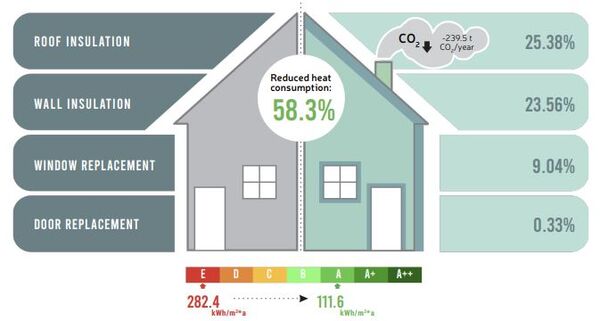Knowledge fuels change
For over a decade, Energypedia has shared free, reliable energy expertise with the world.
We’re now facing a serious funding gap.
Help keep this platform alive — your donation, big or small, truly matters!
Thank you for your support
Difference between revisions of "EEP in Mongolia Technology and Pilots"
***** (***** | *****) m Tag: 2017 source edit |
***** (***** | *****) m Tag: 2017 source edit |
||
| Line 41: | Line 41: | ||
As the measurements of the indoor air temperatures showed, the buildings did not recieve the amount of heat given in the calculated demand. After renovation the buildings recieved enough heat to create a comfortable learning condition and additionally save 40-55 % of heating energy in comparison to their consumption before renovation. | As the measurements of the indoor air temperatures showed, the buildings did not recieve the amount of heat given in the calculated demand. After renovation the buildings recieved enough heat to create a comfortable learning condition and additionally save 40-55 % of heating energy in comparison to their consumption before renovation. | ||
| + | |||
| + | [[File:EEP - Contribution of Refurbishment Measures to Reduction of Heat Loss.JPG|600px|center|Contribution of Refurbishment Measures to Reduction of Heat Loss]] | ||
---- | ---- | ||
Revision as of 08:07, 17 June 2022
Thermo-Technical Refurbishment of Schools and Kindergartens
An important aspect of the project was the possibility to work with all different levels of stakeholders. By implementing pilots in thermo-technical retrofitting at public schools and kindergarten buildings, there was the opportunity to generate real life experiences for stakeholders, data collection and complete training simultaneously. The project refurbished 22 school and kindergarten buildings. The work on those buildings allowed private construction companies to put their newly learned skills into practice, while the municipality could apply new management and budgeting processes.
To enable data collection and comparison of energy consumption, on all objects to be refurnished, before and after renovation, mixing loops and heat meters were installed prior to construction work. The collection of this data allows for the development of a baseline for heat consumption and supply, of public and private buildings in Mongolia. For the first time, theoretically calculated heat demands could be compared with the real consumption before and after renovation. This data showed that thermo technical retrofitting is not only serving the aim of the efficient use of energy, but also improving the learning conditions for children studying in those buildings.
In addition to the pilot buildings improving the current the situation, there were also planning and calculation documents created for many more buildings. Nine building designs blueprints were developed for 117 schools and kindergartens, as well as five design blueprints for 1077 panel buildings. These documents allow MUB to save costs in planning, and enables reliable cost calculations.
Temperature Improvements and Energy Savings
A conducted baseline study has shown that in non-renovated buildings the indoor temperature was as low as 10 – 18°C in wintertime with a clear correlation to the outdoor temperatures. Subsequently children had to wear winter clothes at school. In renovated kindergartens, on the other hand, indoor temperatures stabilized around 22°C regardless of outdoor temperatures.
While increasing the indoor temperature, the project’s aim was also to reduce the heating consumption by at least 40% through energy efficiency measures. The measures were calculated and defined in advance by energy auditors, integrated into the planning and checked again after the refurbishments.
Generally, building energy efficiency can be compared by determining the energy consumption per heated volume / area by either measuring:
- Demand-related efficiency
- Consumption-related efficiency
The energy auditing after the refurbishment has shown that by insulating the buildings (roof, top floor ceiling, exterior walls, exterior doors, exterior windows and floor, lower building closure) energy efficiency could be improved by up to 70% compared to the current demand.
This means that the heating energy demand of
- the kindergarten could be reduced from 400 kWh/ (m2 *a) to 120 kWh/(m2 *a)
- the school from 300 kWh/(m2 *a) to 90 kWh/(m2 *a)
As the measurements of the indoor air temperatures showed, the buildings did not recieve the amount of heat given in the calculated demand. After renovation the buildings recieved enough heat to create a comfortable learning condition and additionally save 40-55 % of heating energy in comparison to their consumption before renovation.
For more information about the project please contact: XYZ






















